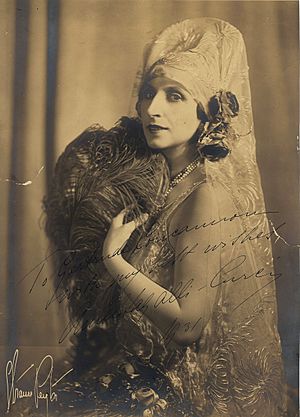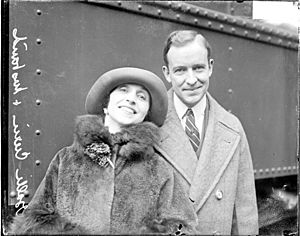Amelita Galli-Curci facts for kids
Quick facts for kids
Amelita Galli-Curci
|
|
|---|---|
 |
|
| Born |
Amelita Galli
18 November 1882 Milan, Kingdom of Italy
|
| Died | 26 November 1963 (aged 81) La Jolla, California, U.S.
|
| Education | Milan Conservatory |
| Occupation | Opera singer |
| Known for | Coloratura soprano |
| Spouse(s) |
|
Amelita Galli-Curci (born November 18, 1882 – died November 26, 1963) was a famous Italian coloratura soprano. This means she was a female opera singer with a very high, flexible voice. She was one of the most loved opera singers of her time, and her music recordings sold a lot!
Contents
Amelita Galli-Curci's Early Life and Training
Amelita Galli-Curci was born Amelita Galli in Milan, Italy. Her family was well-off and had Spanish roots. She started her music journey by studying piano at the Milan Conservatory. She was so good that she won a gold medal for her piano playing. When she was just 16, she was even offered a job as a professor!
Amelita's grandmother inspired her to sing. A famous opera composer named Pietro Mascagni also encouraged her singing dreams. Amelita mostly taught herself how to sing at the beginning of her career. She learned by listening to other singers and reading old books about singing techniques. She even practiced singing by using her voice like a piano. Later, in the 1920s and 1930s, she got coaching from Estelle Liebling in New York City.
Amelita Galli-Curci's Amazing Opera Career
Amelita Galli-Curci first performed in an opera in 1906 in Trani, Italy. She played the role of Gilda in Giuseppe Verdi's opera Rigoletto. People quickly loved her for her sweet, clear voice and how beautifully she performed. Many thought she brought a fresh, lovely sound to Italian opera.
She traveled a lot, performing all over Europe, Russia, and South America. In 1915, she sang in two shows of Lucia di Lammermoor with the famous tenor Enrico Caruso in Buenos Aires. These were the only times they sang together in an opera. However, they did perform in concerts and made some recordings together.
Singing in the United States
Galli-Curci came to the United States in 1916. She wasn't very well known there yet. She planned to stay only a short time. But on November 18, 1916 (her 34th birthday), she made her American debut in Chicago, again as Gilda in Rigoletto. The audience loved her so much that she decided to stay and sing with the Chicago Opera Association. She performed with them until 1924.
Also in 1916, Galli-Curci signed a contract to make records with the Victor Talking Machine Company. She made her first records just a few weeks before her big American debut. She recorded only for Victor until 1930.
On November 14, 1921, Galli-Curci also started singing at the famous Metropolitan Opera in New York. Her first role there was Violetta in La Traviata. She was one of the few singers at that time who worked for both the Chicago Opera and the Metropolitan Opera at the same time. Galli-Curci stayed at the Met until she stopped performing in operas nine years later.
In 1922, Galli-Curci built a beautiful home in Highmount, New York, which she called "Sul Monte" (meaning "On the Mountain"). She spent her summers there for many years. In a nearby village, a theater was built and named the Galli-Curci Theatre in her honor. She performed there on its opening night.
Vocal Changes and Retirement
Galli-Curci grew tired of the politics in opera houses. She also felt that opera might be a fading art form. So, in January 1930, she retired from the opera stage. She wanted to focus more on concert performances instead.
For several years, she had some throat problems, especially with hitting high notes clearly. In 1935, she had surgery to remove a goiter (a swelling in the neck caused by a thyroid problem). Doctors were very careful during the surgery, which was done while she was awake. However, many people thought her voice changed after the surgery. It was believed that a nerve to her larynx (voice box) might have been damaged, making it hard for her to sing high notes. This nerve is sometimes called the "nerve of Galli-Curci."
Later research has suggested that her vocal decline might not have been caused by the surgery itself. Some experts believe that the goiter pressing on her windpipe might have ended her career as a coloratura soprano. But they also think that any nerve damage from the surgery might have stopped her from singing other types of opera roles later on.
Amelita Galli-Curci's Personal Life
In 1908, Amelita Galli married an Italian nobleman and painter named Luigi Curci. She added his last name to hers, becoming Galli-Curci. They later divorced in 1920. In 1921, Galli-Curci married Homer Samuels, who was her piano player. They stayed married until Homer's death in 1956.
Galli-Curci was also a student of Paramahansa Yogananda, an Indian meditation and yoga teacher. She even wrote the introduction for his 1929 book, Whispers from Eternity.
Later Years and Legacy
On November 24, 1936, when she was 54, Galli-Curci made a return to opera. She performed in one show as Mimi in La bohème in Chicago. It was clear that her best singing days were behind her. After another year of concert performances, she fully retired. She lived in California, where she enjoyed painting. She also taught singing privately until shortly before she passed away.
Amelita Galli-Curci died from emphysema in La Jolla, California, on November 26, 1963, at the age of 81. One of her students was the soprano Jean Fenn.
Galli-Curci was a very popular recording artist. You can still hear her voice on old records and newer digital versions. Her beautiful voice and charming singing are still enjoyed today.
Her country home in New York, "Sul Monte," was added to the National Register of Historic Places in 2010.
- Her 1917 recording of Edvard Grieg's Solveig's Song is used in the video game 1916 Der Unbekannte Krieg.
- Galli-Curci has a star on the Hollywood Walk of Fame for her recordings. It is located at 6121 Hollywood Boulevard.
- In the film Grave of the Fireflies by Studio Ghibli, her recording of "Home! Sweet Home!" plays at the end.
- In the 1971 film Wake in Fright, her recording of "Caro Nome" is heard.
Images for kids
See also
 In Spanish: Amelita Galli-Curci para niños
In Spanish: Amelita Galli-Curci para niños





